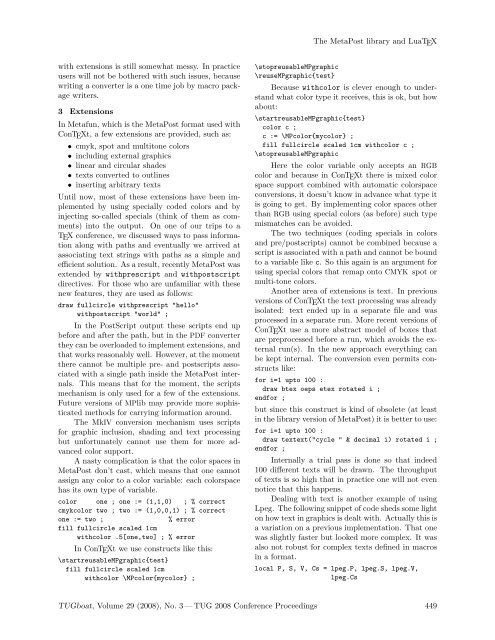The Communications of the TEX Users Group Volume 29 ... - TUG
The Communications of the TEX Users Group Volume 29 ... - TUG
The Communications of the TEX Users Group Volume 29 ... - TUG
Create successful ePaper yourself
Turn your PDF publications into a flip-book with our unique Google optimized e-Paper software.
with extensions is still somewhat messy. In practice<br />
users will not be bo<strong>the</strong>red with such issues, because<br />
writing a converter is a one time job by macro package<br />
writers.<br />
3 Extensions<br />
In Metafun, which is <strong>the</strong> MetaPost format used with<br />
Con<strong>TEX</strong>t, a few extensions are provided, such as:<br />
• cmyk, spot and multitone colors<br />
• including external graphics<br />
• linear and circular shades<br />
• texts converted to outlines<br />
• inserting arbitrary texts<br />
Until now, most <strong>of</strong> <strong>the</strong>se extensions have been implemented<br />
by using specially coded colors and by<br />
injecting so-called specials (think <strong>of</strong> <strong>the</strong>m as comments)<br />
into <strong>the</strong> output. On one <strong>of</strong> our trips to a<br />
<strong>TEX</strong> conference, we discussed ways to pass information<br />
along with paths and eventually we arrived at<br />
associating text strings with paths as a simple and<br />
efficient solution. As a result, recently MetaPost was<br />
extended by withprescript and withpostscript<br />
directives. For those who are unfamiliar with <strong>the</strong>se<br />
new features, <strong>the</strong>y are used as follows:<br />
draw fullcircle withprescript "hello"<br />
withpostscript "world" ;<br />
In <strong>the</strong> PostScript output <strong>the</strong>se scripts end up<br />
before and after <strong>the</strong> path, but in <strong>the</strong> PDF converter<br />
<strong>the</strong>y can be overloaded to implement extensions, and<br />
that works reasonably well. However, at <strong>the</strong> moment<br />
<strong>the</strong>re cannot be multiple pre- and postscripts associated<br />
with a single path inside <strong>the</strong> MetaPost internals.<br />
This means that for <strong>the</strong> moment, <strong>the</strong> scripts<br />
mechanism is only used for a few <strong>of</strong> <strong>the</strong> extensions.<br />
Future versions <strong>of</strong> MPlib may provide more sophisticated<br />
methods for carrying information around.<br />
<strong>The</strong> MkIV conversion mechanism uses scripts<br />
for graphic inclusion, shading and text processing<br />
but unfortunately cannot use <strong>the</strong>m for more advanced<br />
color support.<br />
A nasty complication is that <strong>the</strong> color spaces in<br />
MetaPost don’t cast, which means that one cannot<br />
assign any color to a color variable: each colorspace<br />
has its own type <strong>of</strong> variable.<br />
color one ; one := (1,1,0) ; % correct<br />
cmykcolor two ; two := (1,0,0,1) ; % correct<br />
one := two ; % error<br />
fill fullcircle scaled 1cm<br />
withcolor .5[one,two] ; % error<br />
In Con<strong>TEX</strong>t we use constructs like this:<br />
\startreusableMPgraphic{test}<br />
fill fullcircle scaled 1cm<br />
withcolor \MPcolor{mycolor} ;<br />
\stopreusableMPgraphic<br />
\reuseMPgraphic{test}<br />
<strong>The</strong> MetaPost library and Lua<strong>TEX</strong><br />
Because withcolor is clever enough to understand<br />
what color type it receives, this is ok, but how<br />
about:<br />
\startreusableMPgraphic{test}<br />
color c ;<br />
c := \MPcolor{mycolor} ;<br />
fill fullcircle scaled 1cm withcolor c ;<br />
\stopreusableMPgraphic<br />
Here <strong>the</strong> color variable only accepts an RGB<br />
color and because in Con<strong>TEX</strong>t <strong>the</strong>re is mixed color<br />
space support combined with automatic colorspace<br />
conversions, it doesn’t know in advance what type it<br />
is going to get. By implementing color spaces o<strong>the</strong>r<br />
than RGB using special colors (as before) such type<br />
mismatches can be avoided.<br />
<strong>The</strong> two techniques (coding specials in colors<br />
and pre/postscripts) cannot be combined because a<br />
script is associated with a path and cannot be bound<br />
to a variable like c. So this again is an argument for<br />
using special colors that remap onto CMYK spot or<br />
multi-tone colors.<br />
Ano<strong>the</strong>r area <strong>of</strong> extensions is text. In previous<br />
versions <strong>of</strong> Con<strong>TEX</strong>t <strong>the</strong> text processing was already<br />
isolated: text ended up in a separate file and was<br />
processed in a separate run. More recent versions <strong>of</strong><br />
Con<strong>TEX</strong>t use a more abstract model <strong>of</strong> boxes that<br />
are preprocessed before a run, which avoids <strong>the</strong> external<br />
run(s). In <strong>the</strong> new approach everything can<br />
be kept internal. <strong>The</strong> conversion even permits constructs<br />
like:<br />
for i=1 upto 100 :<br />
draw btex oeps etex rotated i ;<br />
endfor ;<br />
but since this construct is kind <strong>of</strong> obsolete (at least<br />
in <strong>the</strong> library version <strong>of</strong> MetaPost) it is better to use:<br />
for i=1 upto 100 :<br />
draw textext("cycle " & decimal i) rotated i ;<br />
endfor ;<br />
Internally a trial pass is done so that indeed<br />
100 different texts will be drawn. <strong>The</strong> throughput<br />
<strong>of</strong> texts is so high that in practice one will not even<br />
notice that this happens.<br />
Dealing with text is ano<strong>the</strong>r example <strong>of</strong> using<br />
Lpeg. <strong>The</strong> following snippet <strong>of</strong> code sheds some light<br />
on how text in graphics is dealt with. Actually this is<br />
a variation on a previous implementation. That one<br />
was slightly faster but looked more complex. It was<br />
also not robust for complex texts defined in macros<br />
in a format.<br />
local P, S, V, Cs = lpeg.P, lpeg.S, lpeg.V,<br />
lpeg.Cs<br />
<strong>TUG</strong>boat, <strong>Volume</strong> <strong>29</strong> (2008), No. 3 — <strong>TUG</strong> 2008 Conference Proceedings 449

















